VOL.46, NO. 3
Words Radiating Images: Visualizing Text in Abel Gance’s La Roue
Paul Cuff
Abel Gance’s silent drama La Roue (1922) has been credited as both a masterpiece of cinematic innovation and as a miscarriage of retrograde literariness. Divided for its premiere exhibition into a prologue and six “chapters,” the film echoed the format of a popular novel – and its eight-hour timeframe was novelistically expansive. Gance’s protracted tale of desire, grief, and reconciliation possesses aspects that are at once realistic and symbolic, morbid and humorous, pessimistic and uplifting, material and spiritual. The film’s aesthetic nature is no less complex: its abundant visuality (natural locations, superimposition, rapid montage) is underpinned by elaborate textuality (authorial visibility, lengthy intertitles, literary citations). As a creation that is at once lettered and cinematic, adaptive and original, romantic and modern, La Roue demands a flexible critical approach.
Ascription: The Boundaries of Criticism
The narrative of La Roue concerns the engine-driver Sisif (Séverin-Mars), who falls in love with his adopted daughter Norma (Ivy Close) – as does his biological son Elie (Gabriel de Gravone). When railyard owner Jacques de Hersan (Pierre Magnier) discovers this secret, he blackmails Sisif into letting him marry Norma and remove her from Nice to Paris. Soon after Elie discovers the truth about Norma, Sisif’s sight is badly impaired in an accident; father and son are forcibly transferred to a funicular line near Mont Blanc. Norma journeys to the mountains, but Elie is killed by the jealous Hersan – who dies after the fight. The blind Sisif shuns Norma and lives alone, but eventually the two reconcile and the old man dies peacefully.
Contemporary reviews were remarkably consistent in holding this film’s “literary” qualities to be a kind of cultural backwardness. Émile Vuillermoz said La Roue contained “all the elements of a masterpiece” but was grossly imperfect; Gance revealed himself to be an “inspired poet [and an] extraordinary visionary” who “concocts a novelistic tale of the utmost mediocrity” (“Un film d’Abel Gance” 329-30). Léon Moussinac claimed La Roue could only be called a masterpiece by striving to “forget everything about the film that is unbearable if not actually odious,” and by ignoring Gance’s “extreme bad taste” – a “literary [culture] that has nothing to do with [the film’s] visual brilliance” (5). Critics often took romanesque (novelistic) to be akin to romantique (romantic), accusing La Roue’s extensive melodrama of resembling the unwieldy theatrical creations of French romanticism. In repeating the errors of nineteenth-century drama, wrote René Clair, Gance aimed for sublimity but succeeded only in being “grotesque”: “Oh! – if only he would renounce literature and have faith in cinema!” (87-89). This cry of frustration was not without genuine goodwill. Gance’s peers wanted to see him succeed, but felt he needed rescuing from personal inclinations. Vuillermoz beseeched the filmmaker to accept friends’ advice, but the only voice Gance seemed to hear was his own: “he obeys [his genius] with mystic docility” (“La Roue” 3).
Following its premiere in December 1922, La Roue was subject to various anti-literary salvage operations. Ricciotto Canudo proscribed the film be severely reduced into a “rhythmic suite,” wherein formal invention could operate independently of melodrama (“La Roue” 1-2). Gance would indeed prune his premiere version for general release in 1923, and again (more radically) for rerelease in 1924. Yet it was Canudo himself who first reshaped La Roue by turning it into an eponymous three-volume novel (ed. Ferenczi, 1923). It is no small irony that the way to “fix” this literary film was to transform it entirely into prose – and that Gance later tried to do the same. In 1929-30, the filmmaker sought to publish a new adaptation of La Roue. Prevented by Canudo’s widow from reworking the 1923 novelization, Gance commissioned Jean Arroy to create an entirely new text based on his original scenario (ed. Tallandier, 1930). While undertaken to make La Roue more concise, both novelizations in fact expanded Gance’s text for the sake of greater coherence.
Less charitable attempts to reclaim the modernity of La Roue simply denied Gance’s authorship. Since Blaise Cendrars was listed as a production assistant, members of the Parisian avant-garde championed his creative achievements over those of Gance. Ezra Pound deemed the only “essentially cinematographic” aspects of La Roue to be its depictions of machinery in motion and credited these sequences exclusively to Cendrars; the remainder was “the usual drivelling idiocy of the cinema sentiment,” for which he blames Gance without even mentioning his name (273-74). Future generations of critics followed suit: Stanley Lawder claims Cendrars “created those parts of La Roue” which had the most cultural impact (89-90), while Peter Wollen regards “Cendrars’s editing” as “the most influential intervention of the avant-garde” in film history (272). And despite providing a lengthy analysis to show that Gance’s assistant in fact had no creative impact on the shooting or editing of La Roue, Mikhail Iampolski still leaps to credit Cendrars with the film’s title (132-33).
Even the most frequently-quoted review – by Jean Cocteau – praises the film without naming its director: “There is cinema before and after La Roue as there is painting before and after Picasso” (qtd. in Daria 82). This comparison confers a modernist pedigree on Gance’s film while neatly sidestepping the issue of authorship. Cocteau’s position as an avant-garde writer, painter, and filmmaker makes him a convenient spokesperson for the major aesthetic camps of modernist Paris. Recent accounts of La Roue more regularly cite his words than those of Gance’s ambivalent contemporaries – just as the most frequently reproduced poster for the film is Fernand Léger’s cubist collage and not the conventional design issued by Pathé. Indeed, Cocteau’s slogan now appears alongside Léger’s image on the DVD front cover for La Roue.1 Yet the earliest reference to this epigraph is an unreliable hagiography of Gance from 1959, which provides no source whatsoever – La Roue’s stamp of modernist approval may well be spurious.2
Some commentators now override the objections of Gance’s avant-garde colleagues. For Giovanni Dotoli, La Roue embodies “All the painting and all the literature of its era” (14-15). Likewise, Lucy Fischer isolates the most “modern” elements of La Roue (mechanization, psychology) to compare Gance with his established peers: Cendrars, Eisenstein, Freud, Léger, Marinetti, Munsterberg, Dziga Vertov (189-211). Yet this roster is in marked contrast to the authors cited by Gance in La Roue’s intertitles: Baudelaire, Cendrars, Claudel, D’Annunzio, Hugo, Khayyam, Kipling, Sophocles – and in the various editions of the film’s screenplay, which add Byron, Chamfort, Hamp, Pascal, Poe, Shelley, Tasso, Wilde, and Zola to this bibliography.3 Indeed, despite the pioneering visual experimentation of his work, early critics more frequently compared Gance with writers than with filmmakers: Balzac, Hugo, D’Annunzio, and Rostand were common reference points. The “subtlety and richness” of his creations (not to mention their sheer size) expanded the horizons of the seventh art: “Gance did for cinema what Proust did for the novel” (Dutourd 7).
While recent scholars often associate La Roue with an intertextual array of modernist sympathies, this essay will explore neglected literary influences: Gabriele D’Annunzio, Victor Hugo, Rudyard Kipling. I am interested in these figures precisely (perhaps perversely) because of their unfashionability within modern cultural studies. Appreciation for prodigious expressive talent is frequently outweighed by embarrassment at their ideological romanticism (Hugo), nationalism (D’Annunzio), or imperialism (Kipling). Even Gance’s contemporaries (both left- and right-wing) viewed these writers as symptoms of an outmoded sensibility. For Maurice Bardèche and Robert Brasillach in 1935, the idea that this filmmaker was “another D’Annunzio” or a maker of “Hugolian” films signalled Gance’s “total absence of critical sense and even of intelligence” (242-43).
If this cultural milieu was already becoming out-of-date in the 1920s, today it is in danger of being obscured entirely. No complete print of La Roue now exists, while Gance’s quotations fluctuate across surviving copies; even with extratextual evidence from archives, the text of La Roue is liable to exceed any effort to grasp its totality.4 (Indeed, not all the titles I discuss here feature in the forthcoming restoration by the Fondation Jérôme Seydoux-Pathé, which conforms to the general release edition of 1923). Paper evidence for these literary aspects can be as elusive as lost celluloid. Gance met D’Annunzio while performing in his plays and befriended Kipling in the hope of adapting his work, yet scant written correspondence between them survives – and none is published. The nature of artistic influence thus becomes subterranean, a notion Gance readily acknowledged. Though the poet died four years prior to the filmmaker’s birth, Gance felt so strongly connected to Hugo that he considered it a case of literal “reincarnation” (Brownlow, “Napoleon” 24).
Room must be made in the critical imagination for these expurgated and esoteric dimensions of artistic affinity. Accordingly, this article does not so much seek to trace documentary links between artists as to follow the echoes of thought and method across their work. I suggest how various forms of reading and writing are vital aspects of La Roue and seek to highlight overlooked elements of adaptation and intertextuality. As Gance told Jean Mitry in 1923, the relationship between film and literature was based on a sense of emotional and intellectual communion:
Before making an exclusively visual work, I sought to demonstrate the rapport of the “image-text” – in other words, to prove the way images radiate around these quotations.
As a diamond takes in light while its every surface scintillates, so these citations imply and confer different aspects – irradiating their power through the images that gleam around them (“Abel Gance” 8).
Signatures: The Author Within the Text
The necessity for an intertextual reading of La Roue is apparent from its very first image: a handwritten note on paper, signed by Gance, dedicating the film to “la mémoire de ma chère jeune femme, née Ida Danis, morte à vingt-sept ans.” We are invited to read “femme” as “wife,” and Gance’s phrasing oddly implies Ida died under his own name; she did not, for they never married. Yet the filmmaker’s personal loss during the production of La Roue was familiar to his audience, having been widely publicized in the press. Not only did Gance lose his fiancée, but also his close friend Séverin-Mars and his adoptive father Adolphe Gance. In a funeral address for Séverin-Mars, Gance read out a letter he claimed that the actor’s ghost had deposited on his desk in a ray of sunlight;5 his speech compared a memory-laden brain with a necropolis in which the dead “dig their graves” – La Roue was a mystical medium through which the deceased and the living could converse (“Inauguration” 4). Gance was following a path laid by D’Annunzio who, after his experiences during the Great War, regarded himself as “the firstborn of the dead;” literature was a vessel in which author and departed coexisted:
Week after week I live with the dead; my life dies and is restored in them; I lie low alongside them, or raise myself on my elbows to recognize them – to examine them – to re-experience them – or simply to encompass them in my arms (Per l’Italia 398).
In private, Gance obsessively memorialized Ida’s name in his manuscript notebooks and addressed her as if she were still alive; publicly, the published screenplays of Napoléon (1927) and La Fin du Monde (1931) and his autobiography Prisme (1930) all begin with written epitaphs to her. Paper is a fragile bearer of identity throughout La Roue. The only evidence of Norma’s parentage is a manuscript letter that Sisif burns; Elie discovers the truth when he finds a family record book in which Norma’s name is absent. This document also reveals connections between author and characters: the fictional Sisif shares his birthday (25 October) with Gance. Prophetically, Gabriel de Gravone (as Elie) resembles Gance in his youth while Séverin-Mars (as Sisif) eerily resembles Gance in old age. (Contemporaneously, the filmmaker considered adopting the creative pseudonym “Elie Flamme” (“Carnets” 8: [Oct.?] 1919).) Later in La Roue, both siblings hide illicit correspondence inside a violin and the discovery of their papers leads to Elie’s murder.
Gance’s private life was likewise mediated on paper. The woman who began translating the screenplay of La Roue into English was Helen Pollock, a “sweet American girl with the soul of a dragonfly” whom Gance met in New York – and became his first amorous temptation after Ida (“Carnets” 10: n.d. [1921]). By the time La Roue premiered, he had wed Marguerite Danis – the sister of his late partner. Gance continued to make public tributes to Ida, leaving Marguerite painfully conscious of being a substitute for her dead sibling. In the wake of Marguerite’s suicide attempt in October 1930, the couple divorced. Though the press reported this personal crisis, Gance never discussed publicly any other tragedy than that of Ida. D’Annunzio more readily adapted his personal life: he fictionalized his wife’s attempted suicide in Il trionfo della morte (1894); his relationship with Eleonora Duse is laid bare in Il fuoco (1900); his diarized account of an affair with Giuseppina Mancini that ended in her insanity was published partially in the novel Forse che sí, forse che no (1910) and wholly in the memoir Solus ad Solum (1939).
Kipling was famously reticent to acknowledge deep emotional trauma, though quick to adapt it for his fiction. His destructive infatuation with Flo Garrard is entirely absent from the posthumous autobiography Something of Myself (1937), whose text was completed by Kipling’s widow. Yet the experience shaped The Light that Failed (1891), a morbid tale of unrequited love: in his youth Dick falls for Maisie, a fellow orphan; after a successful career as a war artist, Dick reencounters Maisie – who still rejects his love; Dick then descends into bitterness, blindness, and eventual death on a remote battlefield. The novel’s mixture of heterosexual obsession, suggested homoeroticism (Dick and his comrade Torpenhow, Maisie and her roommate), and emotional irresolution clearly appealed to Gance – whose work frequently features the same themes. Gance began negotiations through Pathé to film an adaptation, and in November 1919 he stayed with the author’s family at Burwash. Discussing The Light that Failed, Gance “startled” Kipling by telling him that Maisie was a lesbian – identifying the truth about Garrard’s sexuality long before modern biographers confirmed it (Brownlow, “Rudyard Kipling” 30). Soon after leaving Burwash, Gance embarked upon La Roue – another tale of orphanhood, unrequited love, and blindness. As well as these broad similarities, Gance reworks curious details from Kipling’s novel: both Maisie and Norma own a pet goat, while during their sightless isolation Dick and Sisif are accompanied by faithful dogs (Binkie and Tobie, respectively). Furthermore, Dick’s final painting is a “Melancholia” – inspired by Edgar Allan Poe’s last poem, “Annabel Lee” (1849), another fictionalized account of personal grief. Gance deeply admired “Annabel Lee,” and its theme of post mortem obsession clearly resonated after the death of Ida Danis.
On this theme, Gance’s book Prisme mimics the two-part structure of Victor Hugo’s poetry collection Les Contemplations (1856): a “before” and “after,” separated by the death of the author’s beloved. Like Hugo, Gance was concerned with the universality of fate. The opening quotation in La Roue’s first episode is from Les Contemplations, the preface of which insists on the connection between Hugo’s tragedy and that of his readers: “My life is yours, your life is mine, you exist as I exist; fatality is indivisible” (1: ii). The credit sequence of La Roue likewise imprints its author’s presence: Gance appears first as written signature, then in two cross-dissolved shots of himself gazing out at the viewer. In this haunting prelude, he is superimposed over the smoky environment of railyards – his semi-transparent face aesthetically inseparable from the texture of his filmic world (see Figure 1). Is the fiction emerging from its creator or is the creator dissolving into the fiction? Hugo’s artwork also played with the visual relationship between author and world; in the calling cards he designed, his name merges with the amorphous, inky landscape it inhabits. The illustrations he created for his novel Les Travailleurs de la mer (1866) include a frontispiece in which his name is part of the fiction’s precipitous ocean landscape (see Figure 2). Rather than the permanence of authorial identity, Hugo’s image propels his signature towards dissolution and darkness. For Gance as for Hugo, the author is as fatalistically ephemeral as his protagonists.
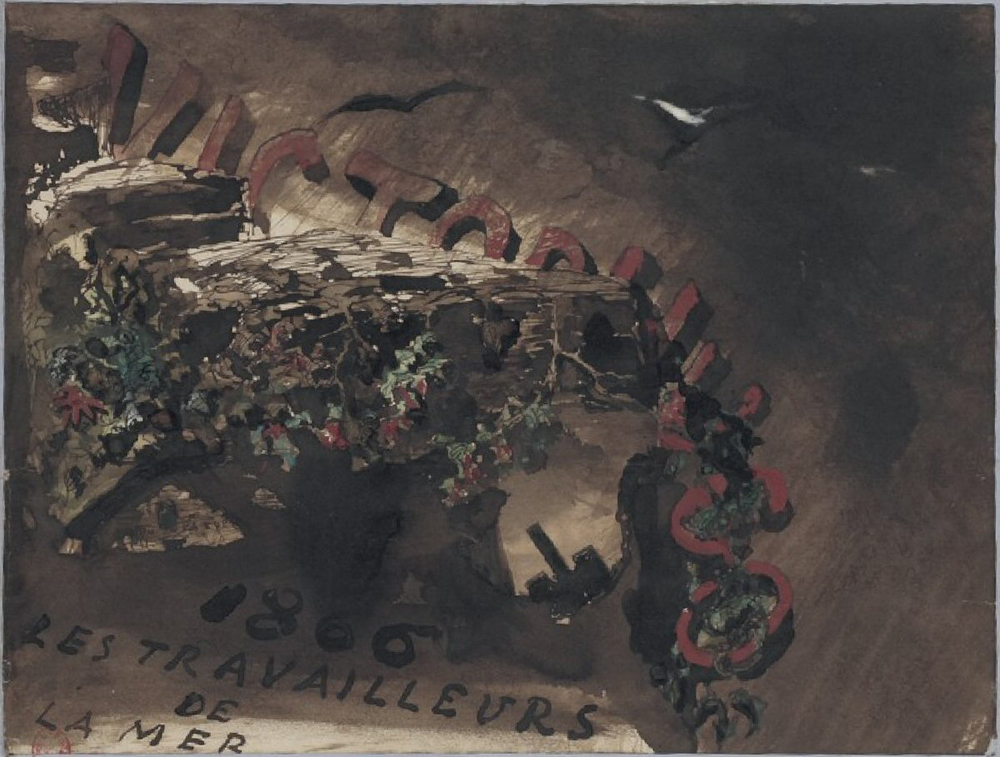
Fate: The Impulse and Influence of Texts
While The Light that Failed provided Gance with elements of dramatic plot, Kipling’s novel Kim (1901) offered a philosophical framework for his protagonists’ destiny – the “wheel” as symbol of mankind’s perpetual enslavement by worldly desire. The moral backbone of this narrative is the pilgrimage of an elderly Lama to Buddhism’s holiest sites. As he explains to his young apprentice: “I go to free myself from the Wheel of Things by a most broad and open road” (Kipling, Kim 13). Removing all contextual information other than Kipling’s name, La Roue cites these words immediately before Sisif attempts suicide – the most pessimistic way of interpreting the original passage. At the end of the film’s prologue (as Sisif ruminates on his decision to adopt Norma), Gance quotes the Lama’s remark on hearing an old soldier describing his sons joining the army: “And they likewise, bound upon the Wheel, go forth from life to life – from despair to despair” (76). The parallel to La Roue is apt, since Elie will grow to follow his father’s destructive psychological path. Gance’s quotations commentate on characters’ actions in the same way as Kipling’s Lama: “all Desire is illusion and a new binding upon the Wheel” (174).
Yet La Roue frequently strays from the Buddhistic resignation of Kipling’s novel to the violent fatalism of D’Annunzio – a clear (if critically unacknowledged) influence on Gance. The dramatic core of La Roue is evident in the filmmaker’s early (unrealized) stage dramas, works that mimic the darker impulses of D’Annunzian tragedy: Les Traîneurs de nuages (1913-18) concerns homosexuality and romantic rivalry between father and son; La Voix du sang (1914-15) depicts a father’s jealousy over the incestuous relations of his estranged son and daughter, climaxing in a massive conflagration. La Roue alludes to and quotes directly from D’Annunzio’s play La città morta (1898), sharing its explicit references to Greek tragedy and taboo-breaking desire. D’Annunzio’s play opens with a character reciting Sophocles’ Antigone to her blind companion and is set during an excavation of the mythical Atreides royal family tomb. Several intertitles in La Roue cite Sophocles’ Oedipus Rex and Gance described Sisif as an “Oedipus of the railroad,” a figure “caught by an ancient force of Fate ... in a mechanical medium” (qtd. in Rivolet 4).
Both La città morta and La Roue hinge on intimate confessions. In a gloomy interior scene in D’Annunzio’s drama, Leonardo reveals to Alessandro that he has fallen in love with his own sister. His recollections come in a broken flurry of words and images: the sleeping Maria’s naked feet “coloured by the flames” of the hearth; the waking “monster” within him; the “infamous dreams” his sister inspires; the “torture” of insomnia in the bedroom that adjoins hers; the fear of committing a “crime” in his delirium; restless eyelids like “fire upon fire.” The act ends with Leonardo and Alessandro standing side-by-side at the window, silently gazing across a landscape, which is “scattered by fires that light up the extraordinarily calm and pure evening” (La città morta 157-66). In La Roue, Sisif’s lengthy confession to Hersan takes place in the shadowy interior of his railyard home, illumined only by firelight. Though titles offer occasional excerpts of his long speech, their content is relayed visually: Sisif’s memories flood across the screen with the fusillade grammar of Gance’s rapid montage – a rhythmic equivalent of his turbulent thoughts.6 Like Leonardo, the first flicker of forbidden desire is woken by the sight of Norma’s bare feet and legs – isolated in repeated close-ups.7 Sisif’s eyes are ringed by the shadows of insomnia, and (again like Leonardo) he recounts his nighttime vigils outside Norma’s bedroom and the barricades he erects to keep himself downstairs. As in D’Annunzio’s scene, at the end of the confession Sisif and Hersan go to the window and look over a twilit landscape punctuated by smoke. Later in La Roue, Gance quotes directly from D’Annunzio’s confession scene. Two cross-dissolved intertitles interrupt the familial reunion of Elie and Norma: Gance uses Leonardo’s words to suggest the corruption of Elie’s feelings for his “sister” – everything within him “becomes poison and contamination” (156-57).
Gance and D’Annunzio infuse the modern settings of their fiction with notions of ancient destiny. Paolo Tarsis, the pioneering aviator of D’Annunzio’s Forse che sí, is referred to as the “builder of wings” and linked to Icarus; named after Sisyphus, Sisif calls himself “the man of the wheel.” D’Annunzio interviewed pilots to glean precise technical terms for his novel, yet he felt that archaic Roman terms were more evocative for twentieth-century machinery – he even tried to get the industry to adopt his own vocabulary. Gance filmed La Roue on location in the railyards of Nice, cast real mechanics as extras, and screened extracts to rail workers to get feedback on the film’s accuracy. Yet during production, he changed his title from the realist slang of “Les Gueules Noires” to the sentimental “La Rose du Rail,” before settling on the symbolic “La Roue.”
Per the oedipal love-triangle in La Roue, in Forse che sí Paolo’s lover Isabella is having an affair with her brother Aldo – the revelation of incest ultimately drives her insane. D’Annunzio also uses Gance’s central image of destiny, describing “the profound wheel” to which the “secret lives” of his characters are “tied” (123). Forse che sí discusses medieval “breaking wheels” and Gance’s film integrates this image within the design of its intertitles (see Figure 3). Paolo’s brotherly co-pilot Giulio tells Vanina that an Indonesian fortune-teller prophesized a garland of roses would be the emblem of his fate. Giulio takes the rose Vanina is wearing with him on his flight, but he crashes and is killed.8 After a fatal train crash, Sisif finds the orphaned infant Norma under a rose bush – a flower caught in her dress. For Giulio, Vanina is the “rose of the sky”; for Sisif, Norma becomes the “rose of the rail”.9
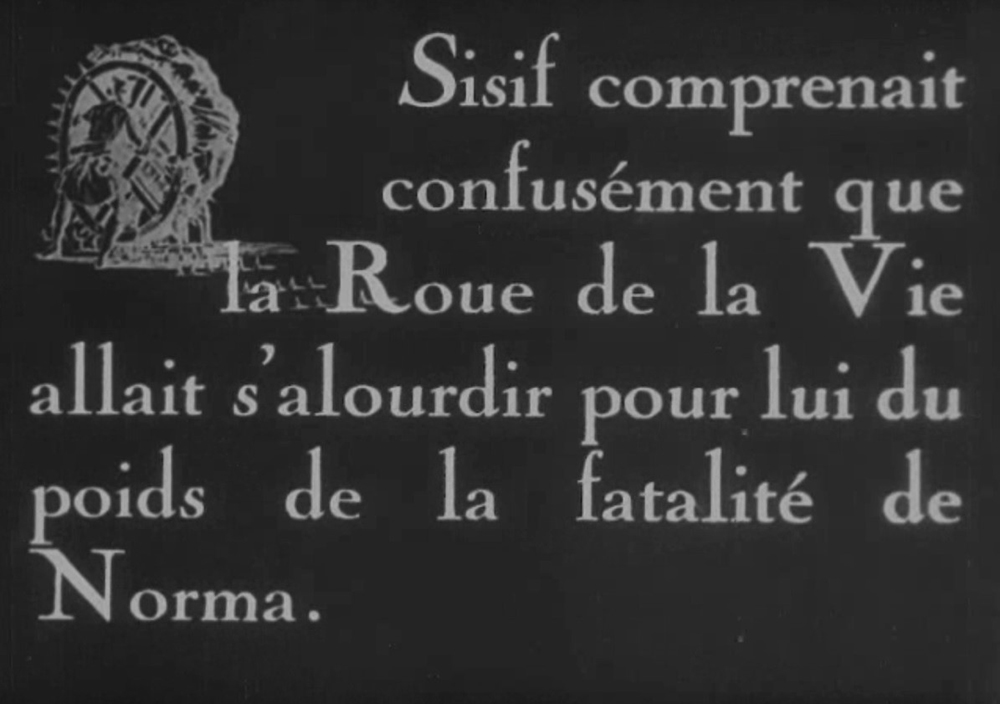
Like Aldo in Forse che sí, Elie is an artistically-inclined youth who uses his creativity to seduce. For Norma, he conjures a vision of the Arcadian world in which he wants to live – and imagines being married to “a woman as beautiful as you.” Through a slow dissolve, Gance transforms Elie into a renaissance luthier – and the film’s tinting switches from blank-and-white to rose, as if the mise-en-scène was itself becoming stained glass. When Elie opens his window, he now looks out onto a terraced garden in which Norma has become a robed maiden with a dove perched on her hand. Gance’s scene exactly matches the transformation provoked by the words of Aldo in Forse che sí. He and his sister Isabella stand looking through a window over a ruined villa, and they mentally recreate the palace around them: a renaissance fantasy in which Isabella is married to Aldo. As this verbal fantasy leads to the siblings’ shared vision of wearing archaic finery, so the gothic font of Elie’s spoken desires presages a visual realization of their content: scripture provokes imagery.
Mise-en-scène: The Language of Images
Though both Gance and D’Annunzio attracted criticism for their verbosity, each sought to surpass the expressive restrictions of language. Gance sought to escape culture’s “worn-out parables” and castigated words as “the Judases of our kingdom” (Prisme 372). He believed that “the ineffable we feel inside ourselves” lay beyond “even our loftiest verbiage:” words “deformed” their intended meaning, accruing “an embellished poetic value which kills their essential value” (68-9). D’Annunzio envisaged a new means of communication successfully expressing the soul’s relationship with the universe: “by giving words unforeseen destinies and by empowering analogies with revelation,” future artists “will make us feel how our spirit is constantly generated, expanded, perpetuated, transfigured by its countless contacts with other spirits and with the mystery of our surroundings” (Libro segreto 160). He imagined an alternative way of reading – or listening – to reality:
the most secret communion of the soul with things can only be grasped here, when we pause; these are the words of silence. the most precise and subtle page of introspection appears coarse and false if we examine it not by the light of intelligence but by the warmth of feeling, seeking to look beneath the falsifying sheen of our habitual verbiage. (159)
For D’Annunzio, the superior artist would act as a kind of translator of the invisible: “Everything speaks to me, everything is a sign for me to read. in all things there is a will to revelation: a will to speak, as in poetry. the fortuitous alignment of objects generates a hermetic scripture” (299). Likewise, Gance believed “the language of silence” would enable humans to communicate with the animate universe around them, and allied this definition with film: “cinema is the translation of the invisible world by the visible world” (“La Cinématographie” 11).
La Roue embodies exactly the kind of sign-filled, poetic reality of which D’Annunzio writes. The mise-en-scène frequently seems sentient, visually remembering and commenting upon the characters and their plight. After Norma has left home, Sisif hides her old clothes in a chest beneath the stairs; his furtive return to this cache of mementoes is interrupted when one of Elie’s violins inexplicably falls from a hook on the wall above him. Startled, he stashes the chest and departs. Elie later appears and retrieves the chest; another violin falls from the wall, and, during his own examination of Norma’s clothes, a vision of Sisif appears in superimposition to threaten him. Achieved by re-exposing the negative in-camera, superimposition allows two separate planes of time to coexist: the frame is invaded by that which is absent. With oppressive regularity, and in a remarkable variety of forms, the past haunts the present in La Roue. Sisif forbids any mention of Norma’s name, yet its text appears in ghostly superimposition in their room – ominously looming in the space between father and son (see Figure 4). Even after the word fades into nothingness, a subsequent scene shows a vision of Norma appearing in Elie’s window. He first tries to shoo it away, next to obscure it behind a curtain, and finally to bury it with his cloak – but the layering of celluloid cannot be undone, and he runs away from the indelible record of Norma’s face.
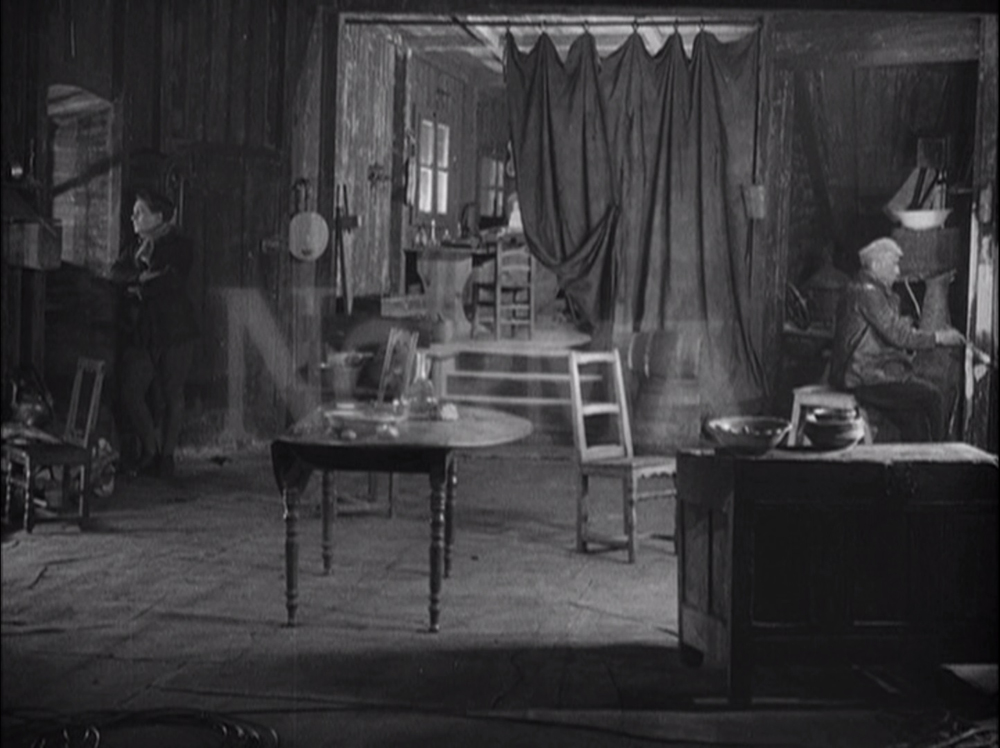
Such readable forms are all-pervasive within La Roue. After introducing each human character through a facial close-up, the film’s credit sequence shows close-ups of mechanical characters: signals, trains, wheels, rails. After titles (absent from many prints) announcing the “Chanson des Rails” and “Chanson des Roues,” there is an elaborate montage of the railyard’s moving mechanisms: inanimate surroundings brought to life through moving images. Furthermore, Gance’s mise-en-scène is perpetually filled with circular forms, asserting the omniscient presence of the symbolic “wheel.” Objective reality becomes subjectively informed; the images of wheels are repeated so often that they come to haunt the imaginations of audience and characters. Kipling uses repeated images for a similar purpose in The Light that Failed; here, the “wrathful red disc” of twilight caught upon a puddle (14) reappears as the “savage red disc” of the sun glimpsed in the desert (33) – and fiery, circular images later haunt Dick’s descent into blindness: “flaming commas and Catherine-wheels floated inside the lids” while “weaving circles and floating pin-heads before his eyes” (200-01). Through extensive color stencilling, Gance realizes the red discs of rail signals in La Roue – and, like Kipling, he fills Sisif’s deteriorating eyes with a dizzying array of circular hallucinations (see Figure 5).
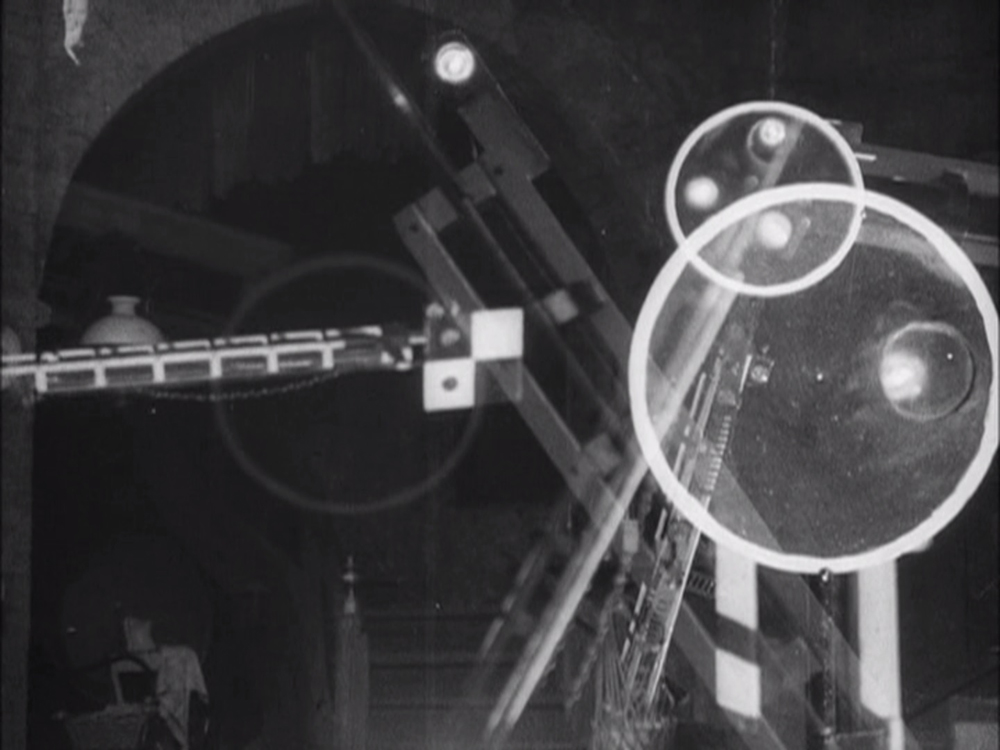
Many of Gance’s intertitles superimpose their text over live action images, transforming the screen into an animate page. Acting as visual voiceovers, they also present the possibility of voices appearing scripturally from within the filmic world. Sisif not only talks to his train engine, but it replies – its words superimposed over jets of steam or clouds of smoke (see Figure 6). Under the assumption that the apparition of these words represents human “delusion,” Kristin Thompson judges this scene “unintentionally risible:”
it comes across as if the train is suddenly talking out loud. In a sound film it’s easy to understand that a sound can originate subjectively in the mind of a character. People don’t, however, tend to imagine sounds as written words!
On the contrary, it is my understanding that the train is talking to Sisif; its words appear in superimposition because cinema allows objects to speak – metaphorically and literally – through celluloid.
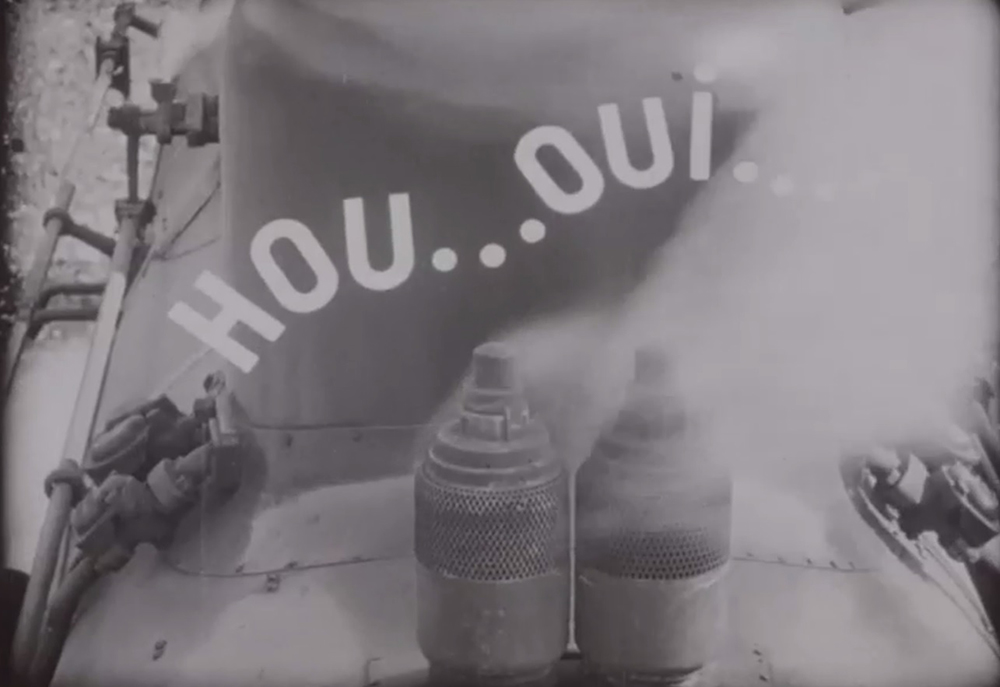
Though many have cited the influence on La Roue of Emile Zola’s La Bête humaine (1890) and Pierre Hamp’s Le rail (1912), the detailed naturalism of these texts lacks the spiritual dimension so central to Gance’s film. In La Bête humaine, the engine driver Jacques Lantier regards his locomotive “La Lison” with quasi-sexual longing; yet while Zola hints at the manmade personality of this machine, he never gives (literal) voice to the train. La Roue has more in common with Kipling’s short story “.007” (1897), which features dialogue spoken by a company of trains. Remarkable apparitions of non-human voices also occur in Kipling’s tale “The Bridge-Builders” (1893), where animal avatars of Brahman gods discuss the construction of a modern railway bridge – and in The Light that Failed, where the sea-poppy associated with the memory of Maisie reappears in the form of a rose that “nodded its head as one who knew unutterable secrets” (243). In La Roue, garden flowers greet Norma with individual cries of “Bonjour!” and bid her “Au revoir!” when she leaves. Gance followed the example of Hugo, whose Les Contemplations features numerous examples of animistic dialogue. In one poem, a churchyard statue and a songbird happily greet each other “Bonjour!” in another, a tree issues a spoken diatribe against the prospect of being felled to make a scaffold (1: 191-93, 307-09). The collection climaxes in a visionary lecture delivered by “the shadow’s mouth,” revealing that the material universe is entirely filled with souls – humankind is only one instance of consciousness (2: 347-84). For these authors, page and screen do not simply document the natural surface of reality but unearth and give voice to its inner life.
Erasure: The Life and Death of Text
In his poem “Le bien germe parfois,” Hugo suggests that inspiration comes unbidden from some unconscious source: “I feel compelled to write all these things/ Which seem, upon the fawn and trembling parchment,/ To issue sinisterly from the shadow of my hand” (Toute la lyre 65). Indeed, Graham Robb claims that Hugo’s “greatest contribution” to modern literature was:
the revelation that words were creatures with a life of their own, that to write a poem was not to go shopping for the best verbal approximation to a known reality, but to engage in a mysterious collaboration, to invent a new reality. (538)
This “mysterious collaboration” between creator and creation was also the subject of Gance’s Prisme (originally entitled “Moi”) and D’Annunzio’s Libro segreto (whose full title translates as “The hundred and hundred and hundred and hundred pages of the secret book of Gabriele D’Annunzio who is tempted to die”). Both works collate a lifetime of private notebooks for public readership; each book acts as a container for the assembly of fragmentary thoughts – the material equivalent of their authors’ bodily vessels. The tonal peculiarity of D’Annunzio’s Libro segreto is rendered scripturally in its absence of upper-case letters within paragraphs; it is as if some aspect of narratorial presence has been surrendered or lost. Beginning with a pseudonymous account of its author’s death, the Libro segreto perpetually returns to the image of writing and erasure. In one passage, D’Annunzio records himself examining a glass goblet: watching the light it projects across the page on which he translates its qualities into prose, marvelling at the vessel’s shadow mingling with that of his hand. The stem suddenly breaks and cuts his flesh, but D’Annunzio continues to write as his page is ensanguined:
The blood drops are like seeds spilled from the fertility of my spirit: beyond symbols, beyond space, beyond time; they vanish into the world’s inexistence, into the immateriality of creatures born and unborn, into the discordance of signs which neither reveal nor conceal themselves. (Libro segreto 34-6)
As this abstract yet intimate passage suggests, D’Annunzio was obsessed with the materials of literature: he evokes “my way of putting aside the written page, taking care that the last line – still wet with ink – doesn’t stain me with blood; the thrilling pause as i select a fresh white sheet to blacken” (lxxvi). The paper, printing, binding, and typeface of his books were as important as their written content. D’Annunzio was especially fond of red ink, and the more elaborate first editions of his plays boast splashes of colored text and linework (see Figure 7). Gance would follow suit in the promotional materials for film premieres, which were as elaborate as D’Annunzio’s first editions (see Figure 8).
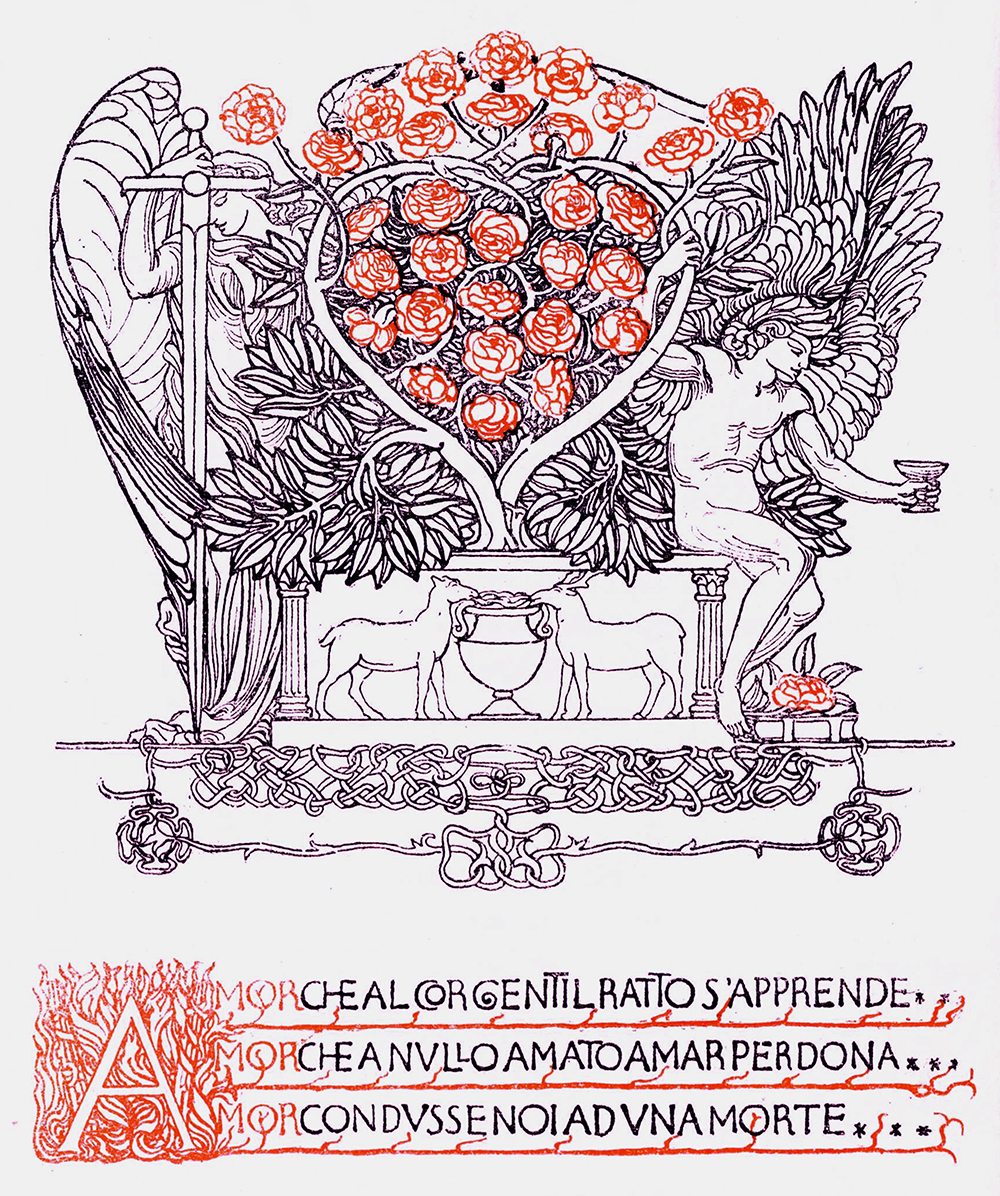
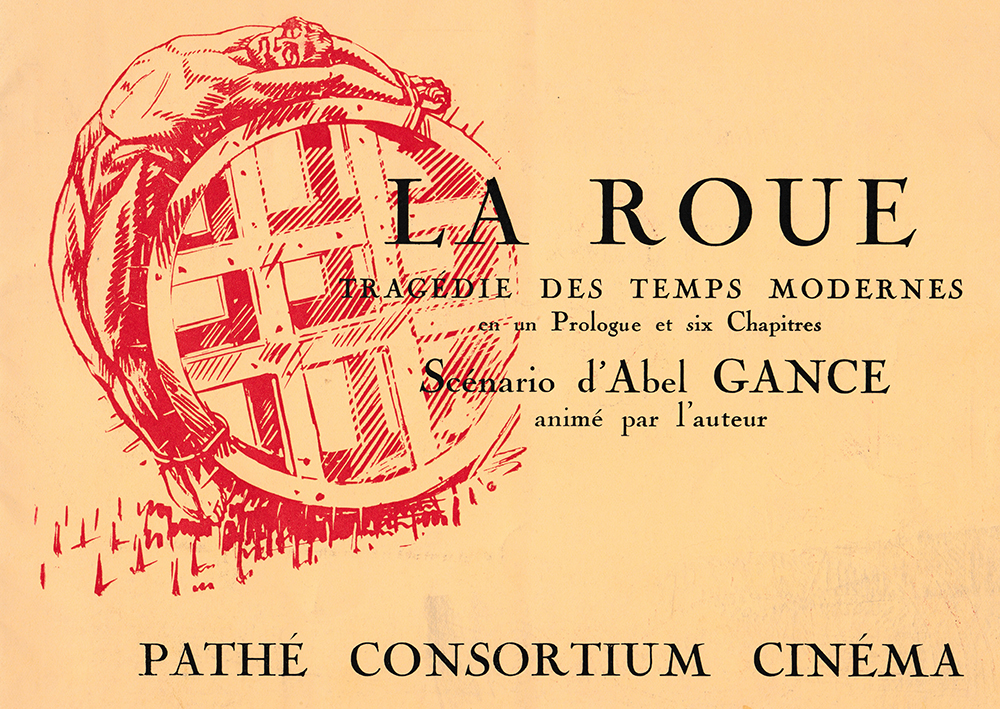
The photographic printing and chemical coloring of celluloid was likewise essential. La Roue features an array of delicate color stencilling: roses blooming red against yellow firelight, lamps gleaming gold in the dark, white snow stained with blood drops. One of the film’s opening shots shows a painted signal over which is superimposed an arm raised in strange concordance – the hand parting the quivering yellow pigment with eerie power. This curious scene presages the later image of Sisif’s hand as a screen bearing the tragic path of his life (see Figure 9). Gance recorded personal instances of coincidence and déjà vu: “Your ultimate words will seize your hand to beg you to write them down. Why is your hand today a supplicant for words?” (“Carnets” 5: 16 Oct. 1917) He believed that ideas could arrive on “psychic waves” projecting from the dead or as “memories of the future” echoing from a predestined posterity (Prisme 65, 124). Though Kipling was reticent to acknowledge these kinds of “psychical experiences,” in Something of Myself, he relates a dream that exactly presaged an event at a memorial service for the war dead; the author wondered why he had “been shown an unreleased roll of my life-film” (215-17).
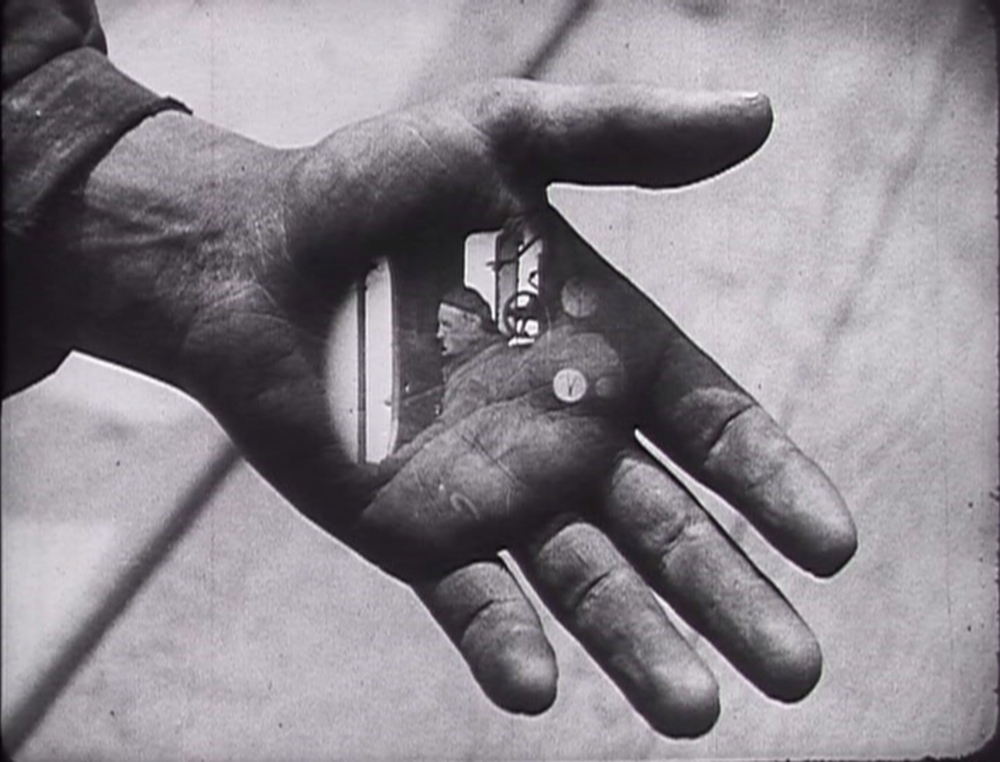
For D’Annunzio, the memory of death was likewise a trigger to intense self-examination. After witnessing the final moments of a friend, he sat down to write:
In the circle of lamplight, I laid my hands on the paper to examine them. … [I]t seemed to me that they lived a life of their own – that they did not belong to me. I raised them and looked at them against the light: they trembled a little, and a red line flared between my grip. I felt pity, then pride. On the thumb, index, and middle finger, my recent labour had deepened the signature of the pen. (D’Annunzio, Contemplazione della morte 92-3)
D’Annunzio found hands perpetually fascinating and his autobiographical works frequently ruminate on bodily deterioration. In his Libro segreto, he describes “the far-off, funereal bearing of my hands. the intensity of their poses: like severed hands that you can know neither by their character nor by their rapport with the owner (presumably deceased)” (118). The author’s fantasy is an appendage that survives without the trunk that carried it in life. D’Annunzio relates a dream in which he undertakes “a fantastic voyage in an airplane that i design to function on land and at sea”; what begins comically as a kind of Georges Méliès film becomes disturbingly surreal, as the craft morphs into his creative organ: “my hand is freed from arms, from torso, from body; it is alone – unique. it rises with my desperate courage toward the sky, like a constellation of five stars” (414-18).
All these images of uncanny creation map the act of writing onto the author’s body: their mutual dependence is both generative and erosive. The first chapter of Hugo’s Les Travailleurs de la mer is called “A Word written on a blank page” and concerns the hero’s name traced in snow – its ephemeral form slowly melting into nothingness, as he himself vanishes into the waves in the final chapter. If the text is a fragile embodiment of identity, so the idea of a blank page is a foreboder of death. This is true for authors as for protagonists. As I discussed earlier, the image of Gance at the start of La Roue positions the author somewhere in-between emergence and disappearance. Physical loss and artistic creativity is a recurrent theme in Gance’s work: the blind poet of his (unrealized) play Homère (1914), the deaf composer and blind singer in his films Un Grand amour de Beethoven (1936) and La Vénus aveugle (1941). Thanks to their extreme length and intricate montage, the labor of editing La Roue and Napoléon caused Gance retinal damage – a cinematic signature akin to D’Annunzio’s imprinted hand.
The wider landscapes of fiction are also sites of textual transubstantiation. In Kipling’s Kim, the Lama repeatedly longs for the isolated splendour of “my Hills,” the Himalayas: “Thus should a man abide, perched above the world, separated from delights, considering vast matters.” (359) The final intertitles of La Roue feature black text on a plain white background – the design is relieved not only from the wheel-wrack motif that marks most captions in La Roue, but from all worldly reference. Visual blankness answers Sisif’s rhetorical question to his dog Tobie: “is the wheel is still turning… up there?” The white design of Gance’s final titles reflects their subject: “Sisif came to leave this life as a ray of sunlight abandons a window at dusk”; “As Sisif’s soul freed itself, one of its shadowed wings caressed again the carefree young Norma as she continued within the Wheel.” Though this written description can seem awkward (particularly in English), its imagery undeniably enhances the subsequent live-action shot: here, we see the shadows of clouds gliding across the snow-covered plateau of Mont Blanc where Norma dances in a communal ronde. Thanks to the preceding text, this sublime natural image bears greater human significance. At the moment of death, Sisif is absorbed by the landscape within the frame and by the transformative medium of celluloid – where all phenomena are passing light and shadow.
The image of a material body passing from substance, through representation, to nothingness is the subject of Kipling’s short story “Mrs Bathurst” (1904). Glimpsing the eponymous woman in a documentary film, a character describes her disappearance from the screen: “she melted out of the picture … like a shadow jumpin’ over a candle” (356); later, they report the discovery of two corpses (one of which may be Mrs Bathurst) that are “burned to charcoal,” the tattoos on their desiccated flesh rendered just as “writing shows up white on a burned letter” (366-67). Kipling’s disturbingly ambiguous tale suggests that like the corpus of fiction, human bodies are impermanent texts. Reflecting autobiographically on the notion of celluloid as a fragile vessel for memory, Gance wrote: “Modern iconoclast, I submit each of my images into the holocaust of its successor so that each one burns the last – just as my idea of tomorrow will burn the one that now dictates this letter to me” (“Carnets” 16: 29 June 1924). The final black-on-white intertitles of La Roue evocatively recall the ink and paper of Gance’s opening dedication. The last shot slowly dissolves from a distant view of Sisif’s inert body to the image of a pale curtain: this unimprinted surface is a veil between the viewer and another reality. La Roue is thus bookended by potent instances of what Gance called “image-text;” the border between presence and absence – life and death – is mysteriously embodied by an empty screen that echoes a blank page. Life passes; writing is erased.
Acknowledgements
For sharing their knowledge of the ongoing restoration of La Roue, I offer my thanks to François Ede, Nina Goslar, Jürg Stenzl, and Bernd Thewes.
Endnotes
1 The designs produced by Pathé and Léger can be seen online: www.unifrance.org/film/11398/la-roue. Accessed 16 May 2018.
2 Though Richard Suchenski (222-23) locates this quotation within a posthumous anthology of early film criticism, the page he cites is in fact intentionally blank. To my knowledge, no edition of this or any other collection of Cocteau’s work discusses La Roue.
3 The only name common to both lists is Cendrars. In the second episode of La Roue, the last words of Cendrars’s La Prose du Transsibérien (1913) appear over a large image of a medieval torture-wheel. (Though the illustrative source is unclear, Sisif owns a reproduction of “Le Supplice de la roue,” a similar image from Jacques Callot’s series Les Misères et malheurs de la guerre (1633).) Cendrars’s joyous account of mechanical speed (originally illustrated with cubist designs by Léger) is thus appropriated into a visual system loaded with archaic emblems of fate. Gance later quotes Cendrars on an otherwise blank title card: “La Roue du désespoir tourne dans les ornières du ciel et éclabousse de boue la face de Dieu!” So that it matches the wording of his other quotations (particularly from Kipling), Gance alters Cendrars’s original line, which reads: “Les roues de la folie tournent dans les ornières du ciel et éclaboussent, de boue, la face de Dieu!” (“Amours” 346). Cendrars’s prose poem was inspired by Chagall’s paintings, but Gance again eliminates this modernist context to concentrate on the tragedy of Sisif’s blindness.
4 For information on the archival sources I have consulted for La Roue (both paper and celluloid), see Cuff, “Interpretation and Restoration”.
5 A page from this manuscript letter was reproduced in Cinéa-Ciné pour tous (15 Dec. 1923, 10), complete with Gance’s own authorial signature.
6 There are similar instances of textual montage in Kipling’s prose within The Light that Failed. Dick summons memories of Maisie in the form of a long list of short scenes, separated by semi-colons and gathered into one long paragraph. These moments are described as “pictures” that pass before Dick “one by one” (74-75).
7 A scene in Gance’s screenplay (but missing from surviving prints) is Sisif’s memory of the half-naked Norma drying herself by the fire after a storm – an image almost identical to Leonardo’s first sexualized memory of Maria.
8 The staccato description of the plane’s rapid fall to earth in Forse che sí is akin to Gance’s cinematic rapid montage of the train crash in La Roue; both disasters are followed by impressionistic views of the wreckage smouldering at night.
9 D’Annunzio’s text also has affinities with Gance’s Napoléon, where the virginal Violine closely resembles Vanina in Forse che sí. Violine loves Bonaparte without ever being acknowledged by him. Like Vanina, she watches her idol fall for an older and more sexually-experienced woman. When Bonaparte weds Joséphine, Violine “marries” the general’s shadow which she projects onto her wall; Gance’s image replicates Vanina’s repeated self-description as “the secret betrothed of a Shadow” (132). Both girls attempt suicide: Violine (who fails) with a heart-shaped vial of poison, Vanina (who succeeds) with a dagger she ritualistically “consecrates” over the garland of roses. Gance also adopts D’Annunzio’s fatalistic tropes from Forse che sí for Bonaparte and Joséphine’s relationship: a clairvoyant predicts Joséphine’s destiny, while a crown of roses becomes the motif of their courtship (its destruction foreshadowing their future divorce).
Works Cited
Bardèche, Maurice, and Robert Brasillach, Histoire du cinema. Denoël/Steele, 1935.
Brownlow, Kevin. Napoleon: Abel Gance’s Classic Film. Photoplay, 2004.
---. “Rudyard Kipling and Early Hollywood.” The Kipling Journal, vol. 85, no. 342, 2011, pp. 18-39.
Canudo, Ricciotto. “La Roue.” Paris-Midi, 23 Feb. 1923, pp. 1-2.
Cendrars, Blaise. “Amours.” Les Soirées de Paris, no. 25, 1914, pp. 345-46.
Clair, René. Cinéma d’hier, cinéma d’aujourd’hui. Flammarion, 1970.
Cuff, Paul. “Interpretation and Restoration: Abel Gance’s La Roue (1922).” Film History, vol. 23, no. 2, 2011, pp. 223-41.
D’Annunzio, Gabriele. Cento e cento e cento e cento pagine del libro segreto di Gabriele D’Annunzio tentato di morire. Mondadori, 1935.
---. Contemplazione della morte. Treves, 1912.
---. Forse che sí, forse che no. Treves, 1910.
---. La città morta. Treves, 1898.
---. Per l’Italia degli Italiani. Bottega di Poesia, 1923.
Daria, Sophie. Abel Gance, hier et demain. La Palatine, 1959.
Dotoli, Giovanni. Cinéma, rythme et modernité. Abel Gance et Ricciotto Canudo ou l’Art de la lumière: “La Roue”. Hermann, 2016.
Dutourd, Jean. “Quand le cinéma français était le premiere du monde: le Napoléon d’Abel Gance.” Carrefour, 2 Mar. 1955, p. 7.
Fischer, Lucy. “La Roue: movies, modernity, machine mind.” Modernism/modernity, vol. 20, no. 2, 2013, pp. 189-211.
Gance, Abel. “Carnets” [manuscript notebooks], 1914-28. 19 vols. Bibliothèque nationale de France, Fonds Abel Gance. 4-COL-36/31-49.
---. “Inauguration du buste de Séverin-Mars.” Comœdia, 19 Oct. 1922, p. 4.
---. “La Cinématographie c’est la musique de la lumière.” Cinéa-Ciné pour tous, 15 Dec. 1923, p. 11.
---. Prisme. Gallimard, 1930.
Hugo, Victor. Les Contemplations. Lévy, 1856. 2 vols.
---. Toute la lyre, vol. 2. Hetzel, 1888.
Iampolski, Mikhail. The Memory of Tiresias: Intertextuality and Film. California UP, 1998.
Kipling, Rudyard. “Mrs Bathurst.” Traffics and Discoveries, Macmillan, 1904, pp. 339-67.
---. Kim. Macmillan, 1901.
---. Something of Myself. Macmillan, 1937.
---. The Light that Failed. Macmillan, 1891.
Lawder, Stanley. The Cubist Cinema. New York UP, 1975.
Mitry, Jean. “Abel Gance nous parle de La Roue.” Cinéa-Ciné pour tous, 15 Dec. 1923, p. 8.
Moussinac, Léon. “La Roue.” Comœdia, 19 Jan. 1923, p. 5.
Pound, Ezra. “Paris Letter,” The Dial, vol. 74, no. 3, 1923, pp. 273-74.
Rivolet, André. “Napoléon à Billancourt.” L’Intransigeant, 8 Aug. 1925, p. 4.
Robb, Graham. Victor Hugo. Picador, 1997.
Suchenski, Richard. Projections of Memory: Romanticism, Modernism, and the Aesthetics of Film. Oxford UP, 2016.
Thompson, Kristin. 2012. “The ten best films of 1922.” Observations on film art, 31 Dec. 2012, http://www.davidbordwell.net/blog/2012/12/31/the-ten-best-films-of-1922/. Accessed 12 June 2017.
Vuillermoz, Émile. “La Roue.” Comœdia. 21 Dec. 1922, p. 3.
---. “Un film d’Abel Gance: La Roue.” Cinémagazine. 23 Feb. 1923, pp. 329-31.
Wollen, Peter. Paris Hollywood: Writings on Film. Verso, 2002.